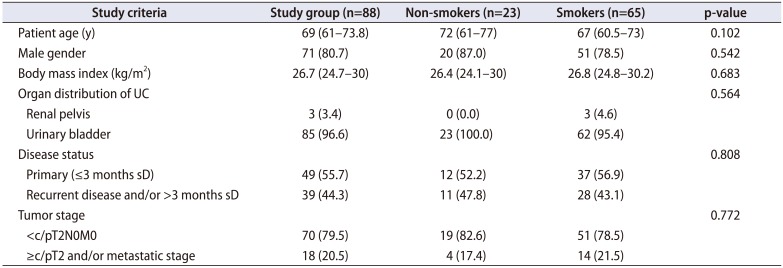1. Cumberbatch MG, Rota M, Catto JW, La Vecchia C. The role of tobacco smoke in bladder and kidney carcinogenesis: a comparison of exposures and meta-analysis of incidence and mortality risks. Eur Urol. 2016; 70:458–466. PMID:
26149669.

2. Freedman ND, Silverman DT, Hollenbeck AR, Schatzkin A, Abnet CC. Association between smoking and risk of bladder cancer among men and women. JAMA. 2011; 306:737–745. PMID:
21846855.

3. McLaughlin JK, Silverman DT, Hsing AW, Ross RK, Schoenberg JB, Yu MC, et al. Cigarette smoking and cancers of the renal pelvis and ureter. Cancer Res. 1992; 52:254–257. PMID:
1728398.
4. Miyazaki J, Nishiyama H. Epidemiology of urothelial carcinoma. Int J Urol. 2017; 24:730–734. PMID:
28543959.

5. Rouissi K, Ouerhani S, Hamrita B, Bougatef K, Marrakchi R, Cherif M, et al. Smoking and polymorphisms in xenobiotic metabolism and DNA repair genes are additive risk factors affecting bladder cancer in Northern Tunisia. Pathol Oncol Res. 2011; 17:879–886. PMID:
21647780.

6. Chavan S, Bray F, Lortet-Tieulent J, Goodman M, Jemal A. International variations in bladder cancer incidence and mortality. Eur Urol. 2014; 66:59–73. PMID:
24451595.

7. Burger M, Catto JW, Dalbagni G, Grossman HB, Herr H, Karakiewicz P, et al. Epidemiology and risk factors of urothelial bladder cancer. Eur Urol. 2013; 63:234–241. PMID:
22877502.

8. Chen CH, Shun CT, Huang KH, Huang CY, Tsai YC, Yu HJ, et al. Stopping smoking might reduce tumour recurrence in nonmuscle-invasive bladder cancer. BJU Int. 2007; 100:281–286. discussion 286. PMID:
17419696.

9. Hou L, Hong X, Dai M, Chen P, Zhao H, Wei Q, et al. Association of smoking status with prognosis in bladder cancer: a meta-analysis. Oncotarget. 2017; 8:1278–1289. PMID:
27902481.

10. Strope SA, Montie JE. The causal role of cigarette smoking in bladder cancer initiation and progression, and the role of urologists in smoking cessation. J Urol. 2008; 180:31–37. discussion 37. PMID:
18485400.

11. Guzzo TJ, Hockenberry MS, Mucksavage P, Bivalacqua TJ, Schoenberg MP. Smoking knowledge assessment and cessation trends in patients with bladder cancer presenting to a tertiary referral center. Urology. 2012; 79:166–171. PMID:
22030373.

12. May M, Gilfrich C, Spachmann P, Maurer O, Dombrowski MK, Fritsche HM, et al. What do prostate cancer patients know about smoking?: results of a bicentric questionnaire study (KRAUT study). Urologe A. 2016; 55:1078–1085. PMID:
27364819.
13. May M, Maurer O, Lebentrau S, Brookman-May S. Lower use of prostate specific antigen testing by cigarette smokers-Another possible explanation for the unfavorable prostate cancer (PCA) specific prognosis in smokers? Cancer Epidemiol. 2017; 46:34–35. PMID:
28012442.

14. Lortet-Tieulent J, Goding Sauer A, Siegel RL, Miller KD, Islami F, Fedewa SA, et al. State-level cancer mortality attributable to cigarette smoking in the United States. JAMA Intern Med. 2016; 176:1792–1798. PMID:
27775761.

15. Islami F, Moreira DM, Boffetta P, Freedland SJ. A systematic review and meta-analysis of tobacco use and prostate cancer mortality and incidence in prospective cohort studies. Eur Urol. 2014; 66:1054–1064. PMID:
25242554.

16. Cao S, Gan Y, Dong X, Liu J, Lu Z. Association of quantity and duration of smoking with erectile dysfunction: a dose-response meta-analysis. J Sex Med. 2014; 11:2376–2384. PMID:
25052869.

17. Bassett JC, Gore JL, Kwan L, Ritch CR, Barocas DA, Penson DF, et al. Knowledge of the harms of tobacco use among patients with bladder cancer. Cancer. 2014; 120:3914–3922. PMID:
25385059.

18. Bjurlin MA, Cohn MR, Freeman VL, Lombardo LM, Hurley SD, Hollowell CM. Ethnicity and smoking status are associated with awareness of smoking related genitourinary diseases. J Urol. 2012; 188:724–728. PMID:
22818131.

19. Westhoff E, Maria de, Aben KK, Vrieling A, Kiemeney LA. Low awareness of risk factors among bladder cancer survivors: new evidence and a literature overview. Eur J Cancer. 2016; 60:136–145. PMID:
27125965.

20. Bassett JC, Gore JL, Chi AC, Kwan L, McCarthy W, Chamie K, et al. Impact of a bladder cancer diagnosis on smoking behavior. J Clin Oncol. 2012; 30:1871–1878. PMID:
22529264.

21. Macleod LC, Dai JC, Holt SK, Bassett JC, Wright JL, Gore JL. Underuse and underreporting of smoking cessation for smokers with a new urologic cancer diagnosis. Urol Oncol. 2015; 33:504.e1–504.e7.

22. Bjurlin MA, Cohn MR, Kim DY, Freeman VL, Lombardo L, Hurley SD, et al. Brief smoking cessation intervention: a prospective trial in the urology setting. J Urol. 2013; 189:1843–1849. PMID:
23159586.

23. Lee AS, Ozakinci G, Leung S, Humphris G, Dale H, Hamlet N. Lifestyle change in the cancer setting using 'the teachable moment': protocol for a proof-of-concept pilot in a urology service. Pilot Feasibility Stud. 2016; 2:65. PMID:
27965880.

24. Pietzak EJ, Mucksavage P, Guzzo TJ, Malkowicz SB. Heavy cigarette smoking and aggressive bladder cancer at initial presentation. Urology. 2015; 86:968–972. PMID:
26190088.

25. Marsit CJ, Houseman EA, Schned AR, Karagas MR, Kelsey KT. Promoter hypermethylation is associated with current smoking, age, gender and survival in bladder cancer. Carcinogenesis. 2007; 28:1745–1751. PMID:
17522068.

26. Kwon T, Jeong IG, You D, Han KS, Hong S, Hong B, et al. Obesity and prognosis in muscle-invasive bladder cancer: the continuing controversy. Int J Urol. 2014; 21:1106–1112. PMID:
25039565.

27. Bachir BG, Aprikian AG, Izawa JI, Chin JL, Fradet Y, Fairey A, et al. Effect of body mass index on the outcomes of patients with upper and lower urinary tract cancers treated by radical surgery: results from a Canadian multicenter collaboration. Urol Oncol. 2014; 32:441–448. PMID:
24412632.








 PDF
PDF ePub
ePub Citation
Citation Print
Print




 XML Download
XML Download